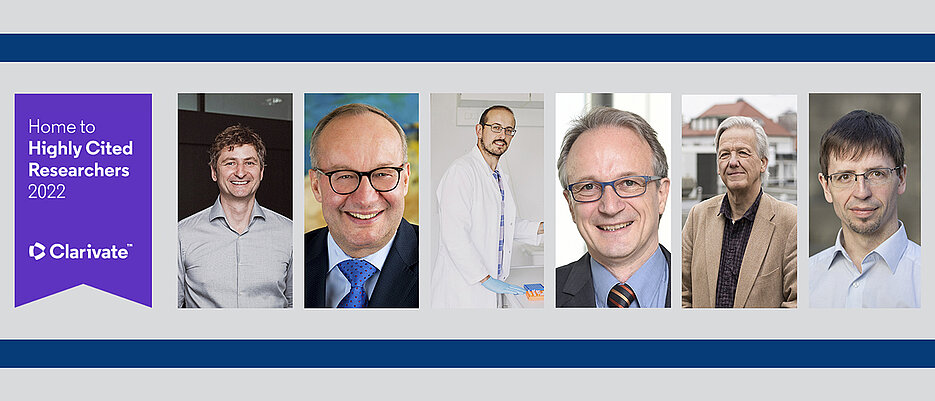Highly Cited Researchers 2022
11/15/2022Their work is most frequently cited in publications of other scientists. Researchers from the University are therefore included in the Highly Cited Researchers 2022 List.

Once again professors of Julius-Maximilians-Universität Würzburg (JMU) in Bavaria, Germany, are on the list of Highly Cited Researchers. Among them are the medical scientist Hermann Einsele, the cell researcher José Pedro Friedmann Angeli, the systems biologist Dominic Grün, the specialist in RNA research and infection biology, Jörg Vogel, and the chemist Frank Würthner.
The current Highly Cited List was established by Clarivate Analytics, a company specialising in citation data, and published on 15. November 2022. The analysis is based on the Web of Science database. For their 2022 assessment, the analysts looked at the time between 2011 and 2021.
Highly cited papers rank in the top one percent of most-cited publications in their field in the year of publication. Only such scholars who have co-authored particularly multiple highly cited papers may join the ranks of "Highly Cited Researchers" comprising some 6,938 scientists worldwide in 2022.
Physicist among the Citation Laureates
In addition to the list of Highly Cited Researchers, Clarivate Analytics publishes the list of so-called "Citation Laureates" which are considered likely to win the Nobel Prize in their respective field. The Wuerzburg physicist, Laurens Molenkamp, has been on this list since 2014. To be eligible for the list, a scientist's published papers must be cited more than 1,000 times. Moreover, their work must concern a trail-blazing discovery or revolutionary progress which the analysts consider worthy of a Nobel Prize.
The Highly Cited Researchers 2022
JMU President congratulates
JMU President Paul Pauli congratulates the researchers: "The fact that Wuerzburg scientists are repeatedly among the Highly Cited Researchers and Citation Laureates is impressive proof of the international visibility of our university. Congratulations to the honourees!"
Prof. Dr. Hermann Einsele
The head of the Chair of Internal Medicine II and director of the Medical Clinic and Polyclinic II is an expert in stem cell transplantation against blood cancer and multiple myeloma and infectious diseases in immune-compromised patients. Immunotherapeutic studies for many tumour diseases are underway under his direction. Einsele has developed a cancer therapy with specifically modified immune cells and used it clinically for the first time in Europe. He has received the 2003 van Bekkum Award of the European Society for Cell and Stem Cell Therapy, 2012 Nobel Lecture Stem Cell Biology/Transplantation, Nobel Forum Karolinska Institute Sweden. In 2014 he was accepted as a member of the Academy of Sciences and Literature Mainz. In 2022, he was the first European to receive the prestigious Erasmus Hematology Award for special achievements in cancer immunotherapy. He is co-spokesperson of the Collaborative Research Centres 124, 221, and 338 and spokesperson of the National Centre for Tumour Diseases WERA with headquarters in Würzburg.
Prof. Dr. José Pedro Friedmann Angeli
The Professor for Translational Cell Biology at the Rudolf Virchow Center for Integrative and Translational Bioimaging at the University of Wuerzburg is a pioneer in the field of ferroptosis, a recently described cell death modality involved in an evergrowing list of (patho)physiological processes. Work in his group aims to understand and exploit specific metabolic pathways that regulate ferroptosis sensitivity. Their long term goal is to exploit this knowledge to selectively target these key survival pathways in cancer entities inherently sensitive to ferroptosis, including B-cell malignancies, melanomas and neuroblastomas.
Prof. Dr. Dominic Grün
The head of the JMU Chair for Computational Biology of Spatial Biomedical Systems and director at the Institute of Systems Immunology investigates processes of cell differentiation in bone marrow and liver tissue using high-resolution methods. His research group has developed numerous bioinformatics algorithms to decipher data obtained with single-cell RNA sequencing. Using these methods, the physicist was able to create the first cell type atlas of the human liver and contribute to a better understanding of tissue architecture and cell differentiation in the liver. His work was awarded the GlaxoSmithKline Prize for Basic Medical Research in 2020. His research on the tissue architecture of the bone marrow has been funded by a two-million-euro ERC Consolidator Grant from the European Research Council since 2019.
Prof. Dr. Jörg Vogel
The director of the Helmholtz Institute for RNA-based Infection Research (HIRI) and director of the Institute for Molecular Infection Biology at the Medical Faculty of the University of Wuerzburg studies regulatory RNA molecules in bacterial pathogens such as salmonella and fusobacteria. His team develops new methods based on high-throughput sequencing to detect RNA molecules in high resolution and to understand how they work. Winner of the 2017 Leibniz Prize, the biochemist is an elected member of the National Academy of Sciences (Leopoldina) and of the European Molecular Biology Organization EMBO.
Prof. Dr. Frank Würthner
The head of the Chair of Organic Chemistry II and founding director of the JMU Center for Nanosystem Chemistry did fundamental research in supramolecular material chemistry. He developed supramolecular polymers and nano-materials based functional dyes for organic electronics and photovoltaics applications. Following successful research on converting sunlight to electricity, Würthner has also experimented with dye-based materials that use sunlight to produce fuels – since 2018 this research is funded by an ERC Advanced Grant. Würthner focuses on biomimetic concepts and synthetic nanosystems. The Society of German Chemists awarded him the Adolf von Baeyer Memorial Medal for his work on dye aggregates.
Citation Laureate Prof. Dr. Laurens Molenkamp
The head of the Chair of Experimental Physics III discovered the quantum spin effect in 2007. Moreover, Molenkamp was the first scientist to implement the new material class of topological insulators in experiments. Since his breakthrough, intensive research has been conducted in this domain. Among others, Molenkamp won a EUR 2.5 million ERC Advanced Grant in 2011 and 2017, respectively, and the Leibniz Prize in 2014. In 2017, he received the Stern-Gerlach Medal, the most prestigious award of the German Physical Society. In 2022, Molenkamp was awarded an honorary doctorate by the Universidad San Martin in Argentina.






